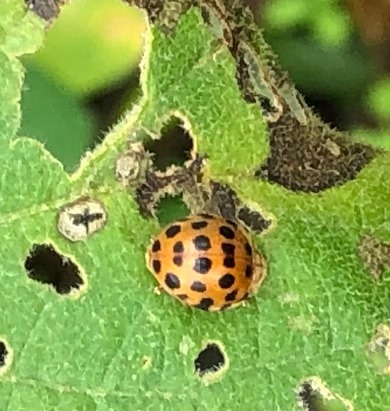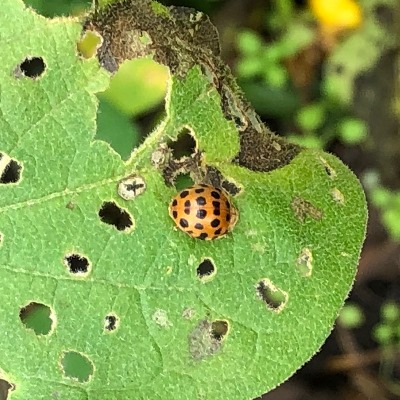Can ladybirds be pests?
Those cute little ladybird beetles and their spiky larvae, are in almost all cases, great to have as predators in the garden. They ladybird subspecies consists of a number of ‘tribes’. Each tribe of ladybirds has a favourite food. Some eat only insects. They may be ravenously hungry predators of spider mites, aphids, thrips or scale insects.
There are also those yellow and black striped ladybirds that eat fungus. (These good guys are pictured on the right)
They are my signal insect that tells me I’m in for a rough trot in the cucumbers if I don’t control the Powdery Mildew with a spray of fish and seaweed and some Eco Carb.

But then there are the leaf eating ladybirds. Now I’m usually pretty happy to have some insect attack, but at the moment, my eggplants are being hammered dreadfully by the leaf eating ladybirds. There are several types, but the 26 Spot and the 28 Spot Potato ladybirds are the ones eating my eggplants. If I had potatoes growing they’d be making a mess of them too.
Later on, they will eat the leaves away from the remaining cucumbers. The adult ladybirds usually eat the leaves from the top. The larvae will hide under the leaf and eat from the safety of the underneath of the leaf. Doing nothing will result in the loss of your plants. Such a shame, as it often happens at peak production time.

Control of these pest ladybirds
To the right you’ll see the recent damage to the eggplants.
I’ve tried all sorts of things to control them in the past. Squashing them with your fingers is best practice, but needs to be done daily.
You can collect lots of them and whizz them up in the blender to make a bug spray. Spray that on the affected plants every second day as a deterrent.
However, my current success is due to the application of a light dusting of Mt Sylvia Diatomaceous Earth (DE) over the plants. As the ladybirds and their larvae travel across the plant or eat the leaves, the DE is either eaten or coats the insect. It kills them via ingestion or by stifling the breathing spiracles. The Mt Sylvia DE is available from nurseries and produce stores. Its allowable in organic agriculture too.
As the eggplants are not often visited by bees, and will self-pollinate in wind, I’m ok with covering the plants with netting to stop other insects being affected until the leaf eaters are under control. And potatoes don’t need to be pollinated either
To see a pictorial catalogue of the ladybirds of Brisbane, take a look at this site…http://www.brisbaneinsects.com/brisbane_ladybirds/LadybirdFieldGuide.html




